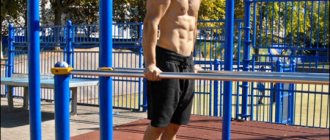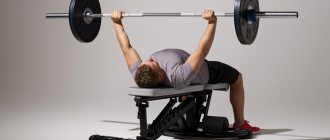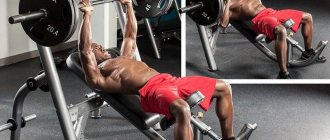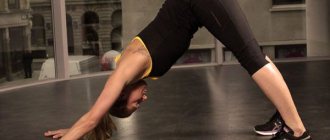The benefits of parallel bars training
To work a specific muscle group, you can change the position of your hands. Standard dips, which form the basis of any training program, have a positive effect, first of all, on:
- triceps
- deltas
- pectoral muscles
You can also pump up your abs on the uneven bars. A workout program that includes leg raises will target your abdominal muscles. Raising your legs while turning your torso activates the oblique abdominal muscles.
The parallel bars training program for beginners does not require the use of weights, and athletes with an average and high level of training can easily diversify the exercises in this way. To do this, you need to take a weightlifting belt and, for example, a set of weights. Alternatively, a parallel bars training program may include dumbbell exercises. Typically, weights are needed to achieve the goals of forming relief and working out the torso muscles.
Types of parallel bars training programs
Training programs on uneven bars can be divided according to the level of physical fitness of the athlete. Beginners are considered to be those who are able to do push-ups 6-12 times, intermediate level - up to 25 times, expert - more than 25 times. Two workouts per week are enough, no more than every other day, so that the muscles have time to recover.
- A set of parallel bars exercises for beginners. At the first workout you need to do 50 push-ups, the number of approaches does not really matter. The ideal option is 5 sets of 10 repetitions. After this, push-ups are performed: 4 sets of 12 times. In the second workout, dips should be done in three sets, with the maximum possible number of repetitions. A 5-minute rest is allowed between sets. The day will end with 4 sets of 10 push-ups.
- Program for intermediate level. On the first day, five sets of push-ups of 10 repetitions, breaks between sets of 2 minutes. Then 3 sets of 12 push-ups. The second workout consists of two exercises that are performed without a break between them. Push-ups on parallel bars and from the floor until failure, in four sets. Rest for 5 minutes is allowed only between approaches.
- Exercises for professionals. The first hard workout again includes dips and push-ups. On the uneven bars, you should do push-ups to failure, then 30 seconds of rest and repeat, another 30 seconds of rest and again push-ups to failure. All this is one approach, you need to do three of them, with a 5-minute rest between them. To do push-ups from the floor, your arms should be placed narrowly. Do 3 sets of 15 reps with 3 minutes rest between sets. The second workout is considered easy: dips, 5 sets of 20 reps.
If a person cannot do push-ups 6 times, it is recommended to limit himself to push-ups from the floor for now. In the early stages, training develops strength and helps build muscle mass. And in the future they develop endurance and contribute to the formation of relief.
The distance between the bars should be slightly greater than the width of the athlete's shoulders. If you perform exercises on the parallel bars with a very large distance, you can get damage to the shoulder girdle. When doing dips, the up and down movements should be slow and rhythmic, but not too fast. The elbows should be kept in the same plane as the wrist, and the legs should be motionless, without swinging. The chest protrudes forward, the shoulders move back, it is important to keep the back straight.
A set of exercises on the uneven bars leads to high energy consumption. You can replenish it with a balanced diet and sports nutrition. When compiling a daily menu, be guided by your training goals; when building muscle mass, you cannot do without additional protein intake.
Every young man wants to have a toned body. There is an opinion among ordinary people that this goal can only be achieved by visiting the gym. This is not so, because there are many cases where a person, working out on horizontal bars and uneven bars, quickly achieved good results. Do you want to repeat this person's success? We will be happy to help you in this matter.
Pull-up technique on the horizontal bar
If you work out at home, you need to have a durable horizontal bar. After all, in the future you will need to do pull-ups with weights. And if you also love dips and need to do reverse crunches, then the Sturm simulator, specially designed for full-fledged home workouts, will help you.
Next, the pull-up technique on the horizontal bar is very important. Yes, yes, pull-ups have their own technique. When you are in the lower position you need to swing slightly forward.
This is a movement invisible to the prying eye. And from there you can pull yourself up. Descending from top to bottom, you need to get to the point below that is slightly ahead and immediately go up.
The grip should be straight (now we are talking about this pull-up). A direct grip is when you place your hands on the horizontal bar from above. If the hands are placed from below, this is a reverse grip.
Particular attention should be paid to the grip width.
You will perform any exercise best if you are comfortable doing it. Those. in our case, if you grab the horizontal bar with a grip that is optimally comfortable in width, then you will do more pull-ups. Right?
If you lift yourself wide, imitating other athletes, you will pull up less than you could. This means that the grip must be optimal. Not too wide and not too narrow. Comfortable.
A narrow grip is used for other purposes.
The optimal grip width is such a grip when, with your chin tucked in, your hands are held above the bar, and your hands hold the bar slightly wider than your shoulders. Inhale in the lower position, and exhale in the upper position. We figured out the technique of performing the exercise.
Exercises on the horizontal bar: types
There are many more exercises that you can do on the horizontal bar than you might imagine. In addition to various pull-up options
, there are the following exercises:
- Raises to work the back muscles.
- Hanging leg raises.
- Exit by force with two hands.
- Various tricks.
So, let's start talking about the different variations of pull-ups. When performing this exercise, the following muscle groups are actively involved in the work:
- Back.
- Biceps and forearms.
- Breast.
In each of the options, all these muscles work. Some are more, some are less. It depends on which option you are doing. Let's look at options with different grip widths:
- Narrow - biceps and forearms are included in the work as much as possible. The chest tenses up quite well. The back receives minimal load.
- Medium - here the chest receives minimal load. And all traction muscles are loaded evenly.
- Wide - work of the chest, biceps and grip muscles is minimized. Almost all the load is received by the latissimus dorsi muscles.
In addition to grip width, there is another factor that will determine which muscles will be involved in the exercise - this is the type of grip. There are only two of them:
- Straight.
- Back.
As you know, to increase the volume of the biceps it is necessary to pump up the brachialis. For those who don’t know, this is a muscle that lies under the biceps. It visually increases the volume of your hands.
So, when performing pull-ups with a direct grip, it is the brachialis that is most involved in the work. And when performing pull-ups with a reverse grip, the biceps itself works very well. For the most productive arm training, it is recommended to alternate these exercises.
One cannot help but mention the range of motion in wide-grip pull-ups. As you know, one repetition is counted when the level of the bar crosses your chin. If you do a pull-up like this, it means you are moving with a short amplitude. When moving over a short amplitude, the work is aimed at developing the width of your back.
Option two - pull-ups to chest level. The amplitude is much greater, so closer to the top point, the work is also aimed at developing the width of the back. Of course, doing this more difficult variation will allow you to do fewer reps. However, such training is of higher quality and will allow you to achieve results much faster.
Hanging leg raises are a very effective exercise for developing the abdominal muscles. Your task is not to simply lift your legs. You should be focused on moving your pelvis upward. Professional athletes recommend imagining that you have no legs when performing this exercise. This will help move your pelvis upward and properly tighten your abs. Over time, it is necessary to increase the height of the legs. Your goal is to reach the bar with your toes.
Torso raises for working the back are very similar to hanging leg raises. The only difference is that you raise your torso. The legs should be straight. Your task is to raise your torso so that your body is parallel to the floor.
The two-handed power-up is one of the simplest gymnastic elements. To be able to complete it, you must be able to:
- Do at least 15 pull-ups.
- Do push-ups on parallel bars at least 20 times.
The essence of this exercise is that you first pull yourself up to your chest, and then turn your hands over until your elbows are facing up. After this you need to do a push-up. This exercise develops both pulling and pushing muscle groups. By doing this exercise regularly, you can achieve a stunning torso in just a few months. It will be very easy for you when you are able to do more than 20 pull-ups per set.
There are more difficult tricks. They require experience and a good level of physical fitness to perform. Such tricks include:
- Checkbox.
- Sun.
- Officer's exit.
- Plank.
Performing these tricks pumps up all the muscles of your body very well. You can start learning these tricks only after six months of training.
Options for Beginners
Now we will bring to your attention several training complexes using a horizontal bar for athletes with low and average levels of physical fitness.
A set of exercises for beginners:
- Pull-ups with a medium straight grip - 2 sets for a maximum of reps.
- Pull-ups with a narrow reverse grip - 2 sets for the maximum number of repetitions.
As a rule, beginner turnstile lifters can do no more than 3 pull-ups in one approach. Your task is to gradually increase the number of pull-ups in one approach. The break between approaches is 3 minutes. You need to train in this program 3 times a week. When you are able to do 12-15 pull-ups per set, you can move on to the next level.
A set of exercises for athletes with an average level of training:
- Wide grip pull-ups.
- Medium grip pull-ups.
- Close grip pull-ups.
Each exercise must be performed with a straight grip, in three approaches for the maximum number of times. The essence of this program is that you start your workout with the most difficult exercise and end with the easiest. The main work will go towards completing a more complex exercise. Accordingly, pull-ups with medium and narrow grips will seem much easier to you. Your task is to reach 20 pull-ups with a medium grip. You need to rest 3 minutes between sets.
After this, you need to try the “Hell Hundred” training program. Its essence is that you perform 10 sets of 10 repetitions. Rest between sets - 1 minute. The exercises alternate in the same order as in the previous program. That is, a wide grip approach, then a medium and narrow one. Alternate variations of pull-ups in a circle until you complete 10 sets. Once you have mastered this program, you need to start training with additional weights.
Program for Beginners
The first thing beginners need to do is learn how to do pull-ups technically correctly. Pull-ups are performed not by the biceps and forearms, but by the latissimus dorsi muscles. This is the basis on which all other exercises are built. The easiest way to do this is to try to bring your shoulder blades together as you lift your body up. No need to swing.
The pulling movement itself should be performed not due to some kind of impulse, but due to compression of the latissimus dorsi muscles. It is quite difficult to feel this movement, and often it takes more than one month of training. But when you learn to do this, your back will begin to grow at an enviable speed. Another option is to use straps, they help to “turn off” your arms.
Before you start performing the complexes, you need to do a test - do pull-ups with a wide grip for the maximum number of times. If you manage to do more than 5, skip the first program and immediately proceed to the second. If you manage to do 1-4 times, start with a simple 4-week program to increase the number of pull-ups:
| Week 1 | |
| Number of approaches | Number of repetitions |
| Day 1 | |
| 5 | 1, 1, 1, 1, maximum |
| Day 2 | |
| 5 | 1, 1, 1, 1, maximum |
| Day 3 | |
| 5 | 1, 2, 1, 1, maximum |
| Week 2 | |
| Number of approaches | Number of repetitions |
| Day 1 | |
| 5 | 1, 2, 1, 1, maximum |
| Day 2 | |
| 5 | 2, 2, 2, 1, maximum |
| Day 3 | |
| 5 | 2, 2, 2, 2, maximum |
| Week 3 | |
| Number of approaches | Number of repetitions |
| Day 1 | |
| 5 | 2, 3, 2, 2, maximum |
| Day 2 | |
| 5 | 3, 4, 3, 3, maximum |
| Day 3 | |
| 5 | 3, 4, 3, 3, maximum |
| Week 4 | |
| Number of approaches | Number of repetitions |
| Day 1 | |
| 5 | 3, 4, 3, 3, maximum |
| Day 2 | |
| 5 | 4, 5, 4, 4, maximum |
| Day 3 | |
| 5 | 4, 5, 5, 5, maximum |
The horizontal bar training program for those who were able to perform more than 5 pull-ups is designed for 3 sessions per week. Other exercises have already been added here. Each workout is quite short, no more than 30 minutes.
| Monday | ||
| "Jumping" pull-ups | 3x10-15 | |
| Horizontal pull-ups on a low bar | 3x10-12 | |
| Wide grip pull-ups | 3x5-7 | |
| Hanging on the horizontal bar | 4xmaximum | |
| Wednesday | ||
| Hanging leg raises to the bar | 3x8-10 | Makatserchyk - stock.adobe.com |
| "Janitors" | 3x6-8 | |
| Imitation of French press on a low bar | 4x10-15 | |
| Hanging on the horizontal bar | 4xmaximum | |
| Friday | ||
| "Jumping" pull-ups | 3x10-15 | |
| Head pull-ups | 3x5-7 | |
| Close-grip pull-ups | 3x4-6 | |
| Hanging on the horizontal bar | 4xmaximum |
Once you can complete the entire amount of work without much effort, begin to slowly increase the number of repetitions and approaches. Also, from time to time, measure your progress separately in pull-ups, because this is the basis of all exercises on the horizontal bar. If you can easily and technically perform 15 reps, it's time to move on to heavier training for more experienced athletes.
Another great option for increasing the load is to use additional weights. A backpack filled with something heavy, such as sandbags or water bottles, works well here.
httpv://www.youtube.com/watch?v=embed/dLjRPXKdZ6c
Types of push-ups
Dips are one of the most effective exercises for working pushing muscle groups. These include:
- Breast.
- Triceps.
- Front delts.
There are two options for performing this exercise:
- For the chest.
- For triceps.
As you might have guessed, the execution technique for these options is completely different. So, to work out the chest on the uneven bars, you must adhere to the following rules:
To work out the triceps, you must adhere to other rules:
- When performing the negative phase, you need to move your elbows back.
- You need to lower yourself to such a level that your arms are bent at the elbows at a right angle.
- At the top point, you must fully straighten your arms. This will make your triceps work better.
- You need to stay in this position for 2-3 seconds. This will help you feel the maximum tension in your triceps.
What about the front delts? They come into play when performing any version of this exercise.
Pushing muscles love high-intensity training. Therefore, an indicator that you are doing everything right is a constant burning sensation in your muscles. We will rely on it when building training programs.
In addition to push-ups, there are other sports exercises on parallel bars. These include:
- Plank.
- Diagonal push-ups.
- Jumping with arms.
- Back push-ups.
Of course, they are not as effective as dips. However, they are very good for completing a workout. And if you feel like you want to diversify your training process, you can include them in your program.
Special programs
To train pushing muscle groups, only dips on uneven bars will not be enough. It is necessary to combine them with various options for push-ups from the floor. That is why we will introduce them into our training complex.
Breast program:
- Chest style dips - 3 sets.
- Push-ups with wide arms - 3 sets.
Triceps program:
- Dips with elbows pulled back - 3 sets.
- Push-ups with narrow arms - 3 sets.
In each approach, you must perform the maximum number of repetitions. The optimal break time between approaches is 2-3 minutes. After you can perform more than 40 dips on the first set, you can move on to a more complex level program.
If you can do more than 40 push-ups, you already have a pretty well-developed figure. Your task is to find the lagging and dominant muscle. The training must begin with an exercise for the lagging muscle. For it you need to perform 4 sets of dips. And for the dominant muscle - 2 approaches.
As a rule, it is quite difficult to reach muscle failure after performing 40 repetitions. After all, you can rest for some time while standing upright on the uneven bars. And then continue with the exercise.
There is no need to count the number of repetitions here. Perform the exercise at a medium pace. And after you feel the burning, you need to speed up and perform another 10-15 repetitions. By the end of the set, the burning sensation in your muscles should be unbearable. With this training program you will increase the size of your chest and triceps. It will also make your body more resilient.
Training principles
To make your training process more productive, you must adhere to the following principles:
In conclusion, we want to give you some advice. They will help you answer any questions you still have.
If you don't know where to start, you can use a special table. This table shows the number of the training week and the number of repetitions per approach. This table is available for both dips and pull-ups. It is designed for 28 weeks. You can find it on the Internet.
Home workouts take much less time. Therefore, in order not to go to the gym in winter, we recommend that you purchase wall bars and a horizontal bar. Working out at home at any time of the day is great. You won't even have a reason to miss your workout.
Now you know how to pump up on the horizontal bar and uneven bars. Don't skip training, and in just a few months you will become the happy owner of a strong and sculpted figure. I wish you success!
Attention, TODAY only!
Bars are perhaps one of the most underrated sports equipment for achieving good physical shape. In addition to the usual working position, in which the conventional chest or triceps are trained, if you have imagination, you can train anything at all. Given that there are parallel bars in almost every yard among high-rise buildings and on every sports ground, you have access to an invaluable exercise machine.
Tips for Beginners
To the inexperienced, it may seem that you can only do pull-ups on the horizontal bar, and do push-ups on the parallel bars machine. But in practice, everything is more exciting, because you can do a wide variety of exercises on these equipment. And load both individual muscle groups and the whole body.
First you need to master grips , which are also used in the workout program for training on the horizontal bar and uneven bars.
The main types of grips on the horizontal bar include:
When pulling yourself up with a wide grip, it is important to load your back muscles. With a narrow and medium grip, the muscles in the chest and arms are actively used.
Train all year round - buy equipment for your home:
What muscles work on the uneven bars?
Let's start with standard parallel bars exercises, where you stand between two pipes, take a stand and lower yourself. A lot depends on the angle and amplitude of the repetitions.
- For example, if you place your elbows out to the sides when doing dips, you will help stretch the lateral part of the pectoral muscle, which will enhance its development. In principle, the pectoral muscles are quite easy to pump in this way.
- If you press your elbows to your body while doing push-ups on the parallel bars, the emphasis is on the triceps.
- When leaning back, you can hit the same triceps and lats much more strongly.
Dips with emphasis on the pectoral muscles
We transfer the load to the main muscles of the chest - the pectoralis major. To do this, you need to spread your elbows to the sides while lowering, bend your knees and lean forward. The second way to engage your pecs is to widen your grip. But for this you need either bars with adjustable width or spread bars (installed in some gyms). The main thing in this matter is not to overdo it with the grip width, otherwise there is a risk of stretching or even tearing the joint capsule. The load will also shift to the latissimus, teres major and lower pectoral muscles. The best option is to use a grip slightly wider than shoulder width and spread your elbows out to the sides at an angle of about 45 degrees to the body; no more is needed. Below is a video example of chest style push-ups:
How to do parallel bars
By experimenting with grips, the load changes or accents are placed. And this is all just with the same type of exercises. The usual exercises that you did on the floor will be transformed into something different if you do it on the uneven bars. For example, push-ups. When performing them on pipes, the amplitude will be much greater, which will allow the pectoral muscle to be pumped very well. There is also a good exercise - a bench press from some surface, where you sit with your back against a bench, put your hands on it and only use them to lift your body horizontally, while your legs just lie on the floor. On uneven bars, obviously, the amplitude is also much greater.
The squat sit-up is a standard abdominal exercise. The problem that often arises on the floor is that when moving, the lower back rubs and becomes uncomfortable.
However, here you should be careful and control yourself. When training on uneven bars, you can lower your body very low. This could be beneficial if it did not cause harm to the spine. Everything needs to be done correctly.
Well, if you have imagination or just a desire to know more, then you can come up with so many different strange and very effective exercises. Such gymnastics on the uneven bars will only benefit you. In extreme cases, they can even be used as a horizontal bar, but you will have to pull yourself up with an angle.
But there is one problem with them - the risk of damaging the joints or getting a sprain. This is easily corrected with good and correct technique.
There are no particular contraindications for uneven bars.
, except for those who have problems with the same joints or those who do not consciously perform the approaches.
If you train in a hot head, just to do it, then there will be more harm.
Top 9 parallel bars exercises
Standard parallel bars press
- Jump onto the bars.
- Press your elbows towards you.
- Work at full range.
Parallel press with elbows out to the sides
- Jump onto the bars.
- Move your elbows away from you to the sides.
- Work at full range.
Forward Press
- Jump onto the bars.
- Tilt your body forward as much as possible, and slightly lift your pelvis and hold it.
Shoulder press
- Stand between the bars.
- Jump up and push yourself up.
- Raise your shoulders up and down.
- Lift yourself up using your upper back.
This exercise will work your trapezius, shoulders and neck well. Analogue exercise.
Lying dips
- Take an emphasis lying on the uneven bars.
- Go down as low as possible, but do not arch in the lower back.
Backward Diagonal Press
- Jump onto the bars.
- Also, place your legs over the pipes in front of you.
- Tilt the body back.
- Go down as far as possible.
Reverse grip bar press
- Jump onto the pipes.
- Place your hands with your fingers facing you.
- Do push-ups.
Walking with hands on uneven bars
- Jump onto the bars.
- Use your hands to move to the other end.
An extremely interesting and useful exercise. Works as a static and strengthens your body. You can play around and complicate it by requiring you to move by jumping with your hands. You can also do push-ups after each shift. It's up to your imagination.
Abs exercise
- Jump onto the bars.
- Raise your straight legs above the bar.
- Move them apart so that they extend slightly beyond the bars.
- Slowly lower your legs down.
Parallel bars training program
Thanks to the versatility of parallel bars, we have a variety that will help you correctly distribute the load on different muscles and increase the duration of your workouts. In principle, as in any other area, the training schedule on the uneven bars is approximately the same - daily or 3 to 1. The difference is that training on the uneven bars every day means strengthening, maintaining and a slight increase in overall tone. If you have a lot of free time and energy, you can do this workout on the uneven bars every day, and on some days you can also do another workout, up to the same muscles. This has a positive effect on overall fitness and discipline.
The order of the set of exercises on the uneven bars is as follows:
- Horizontal push-ups (15 times).
- Standard press (10 times).
- Back press (15 times).
- Press with elbows to the side (10 times).
- Shoulder press (12 times).
- Forward Bend Press (8 times).
- Reverse grip press (7 times).
- Walking on parallel bars with your hands.
Rest between sets for 70 seconds. It is advisable to perform the set twice, but this depends on your physical development. If it’s difficult, then start with one. Climbing is a finishing exercise that is recommended to be done at the end of a workout, not a circuit. The press that was described above serves to not reduce the intensity. It is in this text simply as an example of a good exercise, which, although similar to, is still different. However, if you want to burn more calories, then instead of resting between circuits, do this exercise.
Warm up well to avoid injury.
For beginners in sports
Those who train on parallel bars can try to perform only a standard bench press to get used to it.
For girls
Standard dips and presses are better suited instead of deviations and grip changes.
Push-ups come first in order to, to a greater extent, adapt the muscles to the next load, rather than the joints. The most trivial but important rule is that you train for yourself, not for someone else. This means that every repetition must be of high quality. Don't sag in your pace. Breathe. There is no need to hold your breath when performing difficult tasks. This will destroy your body before you even reach the end of the first circle. AND . This technique will not only improve your performance during training, but also improve the result after it.
horizontal bar. Is it possible to do a horizontal bar, parallel bars, and push-ups on the same day?
You can, of course, but the effect will be better if you do these exercises separately, for example: Workout: Monday, Wednesday, Friday. More often it is not necessary, muscles must grow, and they grow during rest, and not during training. 1) Monday: Reverse grip pull-ups + push-ups (hands shoulder-width apart) 2) Wednesday: parallel bars + push-ups (hands together) 3) Friday: Pull-ups (regular grip) + push-ups (hands on shoulders)
You can do this scheme for a month, then you need to change it: either alternate the exercises, change the order, or change the exercises so that the muscles don’t get used to it. Of course, the number of repetitions must increase, otherwise progress will not be visible. Gradually add 1 rep for pull-ups and several reps for push-ups and parallel bars.
Separate execution is due precisely to the fact that if you do pull-ups with a reverse grip, then you pump the biceps, naturally the biceps and you need to continue pumping, and the parallel bars are designed for the triceps and chest, depending on the correct execution. If you do parallel bars on the chest, then it is better to use them only with wide-grip push-ups, in a word, focus on the chest. Concentrate on one muscle group. For example: Monday: legs + biceps Wednesday: chest + triceps Friday: back + shoulders As you can see, in this example, the training system is designed in such a way that upper body exercises do not coincide on the same day. See more [link blocked by decision of the project administration]
Source
Exercises on parallel bars in video format
Some people are very biased towards training on the uneven bars, calling lovers of these harsh, but simple as a stick, equipment “horizontal bar men”. This probably happens because not everyone can show off their skills on the uneven bars.
In fact, parallel bars are one of the most ingenious human creations. There are parallel bars in almost every yard, and if not, then you can equip them at home and calmly swing and improve your body without paying for going to the gym. Of course, not all muscle groups can be pumped up on the uneven bars (definitely not the legs), but everything above the waist acquires a natural stethema-like beauty and power. Of course, if you do not exclude other equipment and proper nutrition.
Here are 6 must-have exercises on the parallel bars, after which you will not be afraid of anything in life.
Push ups
This requires dexterity and training, otherwise at the initial stage you can beautifully slide off the horizontal bar directly with your face onto your native land. But it’s worth a try, because nothing trains the triceps like this exercise.
1. So, you need to take an emphasis position on the uneven bars with straight arms. 2. Slowly, without unnecessary fuss, bend your elbows, lowering yourself until you are level with the elbow joint. 3. Then, just as slowly, without jerking, return to the starting position.
The main thing is that while performing this exercise, press your elbows to your body and tilt your body slightly back. Do not work with weights under any circumstances, otherwise there is a high risk of injuring the ligaments. In any case, never do this in the first two approaches.
How to start developing muscles
The very first and basic exercise: grab a horizontal bar and hang on it for several minutes.
Then hang again, but only this time begin to slowly contract the muscles and stretch upward. And stopping at the top point, stay in this position for as long as possible. After that, start slowly going down. When you go down, straighten your spine as much as possible, hang a little and jump off carefully. I also advise you to do push-ups and pump up your abs at home, this will allow you to stay in shape when you won’t be able to exercise on the horizontal bar and uneven bars, and if you’re already doing this, then building up will be much easier and faster.
If your body has not yet adapted to the loads that lead to weight gain, you need to gradually increase the intensity of your training in proportion to muscle development. For example, do a warm-up (as described above) and do pull-ups on the horizontal bar as many times as possible for you at this stage. Then rest for a couple of minutes and do some pull-ups again. Rest again and do the third approach. At the very beginning of training, you should not expect outstanding results from yourself, and in the absence of such, in no case should you be upset or engage in self-flagellation. Everything takes time.
Here are a few basic exercises that will help you gain weight on the horizontal bar:
1) Wide-grip chest pull-ups
Grab the horizontal bar with a straight, wide grip, and while inhaling, pull yourself up to a position where your chest is at the same level as the horizontal bar itself, while your elbows are fixed and in the same place. After holding this position for a fraction of a second, slowly and at the exit, lower yourself to the starting position.
2) Pull-ups on parallel bars
Grasp the bars with your hands with a regular grip so that your palms face each other. At the same time, throw your legs back onto the bars, fixing them with your feet. After this, hang on your straight arms and begin to pull yourself up as high as possible, keeping your back straight.
3) Dips
Get into exactly the same position as described in the previous exercise and do push-ups as if you were on the floor. At the same time, try to keep your back straight, and you can even bend lower so that the amplitude of muscle contraction is maximum.
4) Close grip pull-ups
Grasp the bar of the horizontal bar so that the maximum distance between your palms is approximately 10 centimeters. At the same time, the hands are closed into a fist. And pull yourself up to a position where your wrists touch your chest. With a direct grip, the maximum load is placed on the biceps, and with a reverse grip, the maximum load is placed on the muscles of the forearm.
5) Wide grip pull-ups with rear bar
A very powerful exercise for developing the shoulder muscles and latissimus dorsi. You need to grab the crossbar with a straight, wide grip and pull yourself up so that in the raised position your head is in front of, not behind the crossbar, and the horizontal bar touches the stove from behind.
Also, do not forget to eat well and nutritiously so that your muscles can take the necessary amount of proteins and amino acids for growth. Good luck!
MY
about the author
Greetings, dear friend!
My name is Egor Sheremetyev. On my website you can find answers to many questions regarding dating, dating and building relationships with girls.
Please give your opinion about my article
For me it is very important, because... I made the blog for you and I want it to be really useful. Your opinion will allow me to verify this or become an idea for a new article
Your opinion will allow me to verify this or become an idea for a new article.
Diagonal push-ups
In this exercise you need to slightly swap your legs and arms. Simply put, it must be performed strictly upside down.
1. So, place your palms on the ground slightly wider than your shoulders, and place your straight legs on the bars: one leg on one bar, the other on the other. 2. Make sure that the body is in a single line with the legs. There is no need to raise your pelvis and bend your knees. Even if you stand diagonally to the floor, there is nothing wrong with that. 3. It’s very simple - bend your elbows, bringing your face as close to the floor as possible. 4. Return to straight arms and repeat all over again.
You can perform exactly the same diagonal push-ups. In this case, for each repetition the emphasis is placed first on one edge and then on the other. The emphasis point forms a sort of straight line with the leg, keep this in mind.
How to do push-ups correctly?
When starting to master the horizontal bar and parallel bars exercise machines, it is important to keep your balance and not “dangle.” Otherwise, you risk getting sprains and injuries.
Standing along the bars, push off the ground with your feet, then grab the bars with your straight arms. Stay straight. Jump off smoothly. You need to reach the uneven bars using your arms and shoulders.
It is important to do push-ups correctly. Bend your knees (to a right angle), then cross them (as shown in the photo above)
This will add stability. Bend slightly forward, and as you exhale, bend your elbows to a right angle. Do not spread your arms to the sides; your elbows should be pressed as close to your body as possible.
As you exhale, straighten up. If you feel warmth in your triceps, you are doing everything right.
To work the pectoral muscles, go lower. But the angle at the elbow should be about 30 degrees. At first, it is better to refuse such a complication. And when the body finds it easy to do the initial version of the exercise, move on to the more complicated version.
The break between approaches should be up to 2 minutes.
By the way, classes on horizontal bars are suitable not only for guys, but also for girls themselves, who also take care of their body and lead a healthy lifestyle.
If in your yard, in addition to horizontal bars, there are also bars, then this is an additional plus. Thus, you can not only pump up your pectoral muscles, biceps, triceps and other muscle groups, but also normalize your breathing. By the way, professional athletes separately train breathing techniques while lifting weights, so this is a very important point in the training process.
By the way, you can practice at home, because many people probably still have a pull-up bar. Of course, there is more space outside, and fresh air has an additional beneficial effect, but in winter this is quite problematic
In general, the place for training does not have any special selection criteria; it is only important to follow certain recommendations for beginners that are given by more experienced athletes
Hanging crunches
Another exercise that needs to be done upside down. Who said crunches can't be done on parallel bars? Stop communicating with this person, because he is your enemy. The main thing is to do everything efficiently and without risk to life.
1. Throw your legs onto one bar of the parallel bars and hook them onto the second so that one bar passes under your knees, and the second above your ankles. 2. Hands behind your head, elbows to the sides. Pull your chest towards the bar.
Remember not to do this exercise for too long, otherwise you will get a stroke. The exercise itself is noticeably more difficult than usual, because it affects not only the work of the muscles, but also your position. Everything seems more complicated upside down.
Lifting straight lines with a turn
An exercise in the style of “two birds with one stone.” Here you get an equally good load on your arms and on your abs. However, we must warn you that performing this exercise is much harder than it might seem at first glance.
1. Stand on straight arms, bringing your legs slightly bent at the knees slightly forward. 2. Smoothly raise your legs above the bars. The slower the better. 3. Now, without lowering your legs, turn first to the right and then to the left. 4. After this, return to the starting position, lowering your legs down. Then repeat.
Jumping on hands
The exercise is as simple as it may seem. Nothing supernatural, just jumping on your hands. However, before doing this, make sure that the shell will not fall apart under you.
1. Stand on straight arms. 2. Trying to help yourself with your feet and not bend your elbows too much, jump on your hands as high as possible. 3. If you are doing an exercise on long street bars, you can “jump” along the length of the bar from one end to the other.
Try not to do the exercise on your last breath, because it is very easy to injure yourself while doing it.
Back push-ups
The same, but the load falls on the back muscles. A very effective exercise for those who want to pump up evenly.
1. Stand with straight arms on the bars, turning your back to the bars. 2. In the starting position, your arms should be slightly bent at the elbows. 3. Bend your arms and lower yourself as low as possible, trying to touch the limit of your strength. 4. Return to starting position and repeat.
On uneven bars, as in any intensive work with an apparatus, the hands especially suffer. If you work especially hard, you can grind your hands into dust, leading to hanging bloody scabs and calluses that can embarrass Satan himself. That's why normal people always wear gloves. With fingers, without fingers, blue, red - you choose, but if you want good ones - take them
The minimum requirements for the first level are to do push-ups on the uneven bars 6 times, no less. If you can’t do 6 push-ups, then do push-ups from the floor for now (it’s too early for you to do parallel bars).
You need to do this program twice a week (for example: Monday, Thursday), on other days train other muscle groups.
Program for level 1 (those who do dips 6-12 times)
Workout #1
— You need to do 50 push-ups per workout. For example, someone can do 5 sets of 10 repetitions, someone 10 sets of 5 repetitions. In total, you should do 50 dips during the workout. Rest no more than 2 minutes between sets.
— Push-ups: 4 sets of 10-12 times.
Workout #2
— Do 3 sets of dips with the maximum number of repetitions. Rest between sets - no more than 4 minutes.
— Push-ups: 3 sets to the maximum.
Training schemes
The first thing you need to do is purchase a push-up belt. Remember, progressive overload is the most important component of successful training. We won't be doing all those complicated moves that gymnasts perfect every day, so your job is to add weight or go faster. Once you finish the workout with all reps, increase the load. Bodyweight push-ups in a 5x10 pattern will help lay the foundation from which you need to build to avoid becoming a mediocre powerlifter.
For the first three weeks, you will use a basic 5x5 pattern for pull-ups and push-ups. Remember that 5x5 gives you two options. You can increase the weight a little each set, or you can use the same weight each round, even if you start with bodyweight.
The second three-week block involves increasing volume using a basic 5x10 pattern. Again, you can increase the weight a little each set or work with the same load, even if it's body weight. You'll also be combining movements into supersets, but with a little more rest than traditional supersets.
In a 5x5 pattern, you start with pull-ups, rest for 1 minute, do push-ups, and then take a 2-minute break before starting the next round. In the 5x10 pattern, you rest 45 seconds before doing push-ups, and another 90 seconds before starting a new round.
The third phase of the protocol involves performing pull-ups and push-ups in the OP-21 style (rest-pause) according to the 7x3 or 6x5 pattern. Please read the article about OP-21 for a better understanding of the basic principles of this protocol.
- Weeks 1-3:
5x5 - pull-ups and push-ups, rest 1 minute between exercises and 2 minutes between sets. - Weeks 4-6:
5x10 - pull-ups and push-ups, rest 30-45 seconds between exercises and 60-90 seconds between sets. - Weeks 7-9:
OP-21 - pull-ups and push-ups using 7x3 and 6x5 patterns on the same day. Do pull-ups using the 7x3 pattern, rest for 2-3 minutes, and then do push-ups on the parallel bars using the same 7x3 pattern. After push-ups, rest for 2-3 minutes before doing pull-ups using a 6x5 pattern. Rest for 2-3 minutes and do push-ups according to the 6x5 pattern. Please see training diagram OP-21 to understand the principles of 7x3 and 6x5 sets. - Weeks 10-12:
duplicate weeks 1-3, but with a higher load. - Weeks 13-15:
duplicate weeks 4-6, but with a higher load. - Weeks 16-18:
duplicate weeks 7-9, but with a higher load.











